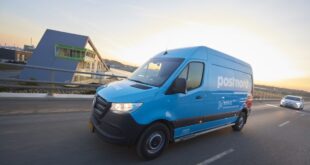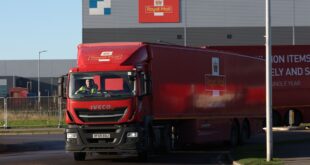With 50,800 vehicles, the Royal Mail operates the largest fleet in the UK by a large margin. The business aims to be net zero carbon by 2050, and with vehicles and transport responsible for nearly two-thirds of its carbon emissions, it is accelerating its adoption of electric vehicles. This year, Royal Mail has announced a ten-fold increase in its electric van fleet, with an order for 3,000 new e-LCVs, and it has announced that by 2025 only electric cars will be available to order across all of its company car schemes. Royal Mail is also at the forefront of exploring new zero emission technologies, trialling micro electric vehicles and even autonomous flying drones.
In an exclusive interview with Fleet Europe, James Baker, Chief Engineer & Fleet Director at Royal Mail (pictured below), outlines how the company is transitioning to electric vehicles.
How is Royal Mail choosing which operational roles to transition first to electric power?
We take very seriously the role we have to play in reducing emissions associated with our fleet. We are building on our ambitions to become a net zero carbon emission business, with a 100% alternative fuel fleet. As part of this drive, we are constantly refining our fleet strategy to bring it in line with changes in environmental legislation as well as the growth in parcels and the transformation we continue to drive within our business. We are committed to purchasing the cleanest technology available wherever possible. As part of this process, we assess all market options in terms of selecting the right alternative fuel vehicles for specific roles. We take into account vehicle range, load capacity, and charging infrastructure requirements. We then align these to the most appropriate operational role. The current generation of electric vehicles are best suited to collection and delivery. We are trialling battery technology improvements, and are seeing whether vehicles for longer routes can also transition to electric. In May, we launched 29 low emission gas powered trucks, fuelled by Bio-Compressed Natural Gas (Bio-CNG).
What size of vehicles are being electrified first?
We are currently focusing on small vans on collection and delivery routes due to the low vehicle mileage and number of hours required back at delivery offices to be charged. In June, we announced plans to introduce around 3,000 additional, low-emission electric vans throughout the UK. The vehicles are specially designed to help postmen and women deliver letters and parcels in a secure and environmentally-friendly way. With load capacities ranging from around 3.7m3 to 6.3m3, the vehicles will operate as part of the Company’s usual delivery routes.
How many EVs does Royal Mail currently have, and what is the timeline for this figure to rise?
Royal Mail recently announced a ten-fold increase in the number of electric vehicles it runs across its UK fleet with plans to introduce around 3,000 additional, low-emission vans throughout the UK. The addition of this latest tranche of electric vehicles brings the total amount of electric vehicles operating within Royal Mail’s fleet to around 3,300.

What role are e-cargo bikes and e-trolleys playing in Royal Mail’s electrification plans?
We continue to look at a number of electrically powered vehicles below car/van size. These may in time play a role in delivery in areas where cars and vans are either discouraged from entering or a smaller vehicle is more appropriate. A six-month trial of the Paxster Cargo and the Ligier Pulse 4 micro-electric vehicles (pictured above) has just started. The vehicles have a load size of between 1.2m3 and 2.0m3 which is enough volume to carry more than an average daily round’s worth of letters and small parcels. Plus, the vehicles are charged using a standard three-pin plug [wall socket], making charging more flexible.
Which geographical locations are first on the agenda for electrification?
The roll-out of electric vans will initially focus on areas introducing ultra-low or zero emission zones. We are working with locations across the UK with strong environmental ambitions, as well as those areas that we deliver parcels to the most to ensure maximum impact.

What challenges is Royal Mail encountering when installing charging infrastructure in its depots, and what solutions is it deploying?
We are building on our ambitions to become a net zero carbon emission business, with a 100% alternative fuel fleet.
In May we launched our first ever Delivery Office to feature an all-electric fleet of collection and delivery vehicles. The Bristol East Central Delivery Office (pictured above), located in the City’s Easton area, had its 23 diesel delivery and collection vans replaced by fully electric equivalents – comprising the Office’s entire collection and delivery fleet. Six electric charging posts were also installed on the site as part of the transformation. The electricity for powering the office and for charging the vehicles is from 100% renewable sources.
Bristol was selected due to the city’s plans for a Clean Air Zone (CAZ), which will require certain vehicles to pay a daily charge to enter its centre. At present, other Delivery Offices across the UK are being considered for similar fleet makeovers in coming months – particularly those in places with existing CAZs, or that have plans to introduce them.
We continue to monitor Grid capacity and ensure that it is in line with the number of vehicles we are looking to deploy at any given site. We also work with our landlords at sites where we rent property to ensure they are comfortable with the installation of electric vehicle chargers which can be complex and time consuming.
What possibility is there for an operational change that would allow drivers to take vehicles home to recharge them?
We are primarily focusing on charging at work. In our Bristol East Central Delivery office, our first ever Delivery Office to feature an all-electric fleet of collection and delivery vehicles, we installed six electric charging posts on the site as part of the transformation.
How will the age / mileage holding period of an EV differ from the standard holding period for diesel vans? How do the wholelife costs of the EVs that Royal Mail is buying differ from internal combustion engines?
It’s still early days. We continue to assess how transitioning to electric vehicles will impact serving and maintenance costs and eventually residual value. This will in turn help inform if we need to revise the age policy for our fleet. For Royal Mail, electric vehicles are the right move for our environment, our people and our communities.
What training are drivers undergoing before they drive the EVs?
Royal Mail recognises that driving an electric van is different to other vehicles so we have developed a bespoke vehicle familiarisation course along with customised maintenance and breakdown recovery processes.
What zero emission vehicle technologies is Royal Mail considering for its trunking operations (not last mile)?
Following a successful trial of two compressed natural gas trucks we expanded the use of these low emission vehicles, with the addition of 29 compressed natural gas trucks, fuelled by Bio-Compressed Natural Gas (Bio-CNG). The use of Bio-CNG in a vehicle can reduce CO2emissions by around 84 per cent, compared to an average diesel vehicle. Bio-CNG fuelled vehicles also offer a significant reduction in particulate matter, compared to their diesel equivalents. Bio-CNG fuelled vehicles generally have a similar refuelling time to diesel and can travel similar distances. Bio-CNG fuel is also significantly more cost effective than diesel. These trucks operate from Chorley and Preston Vehicle Operating Centres, and Warrington Parcel Hub, close to refuelling facilities operated by CNG Fuels. We also continue to assess the market to understand whether hydrogen or electric will be a viable solution for our trunking operation.
Don’t miss our guide to the incentives for electric vehicles across Europe.
Images: Shutterstock, Royal Mail
Source link


